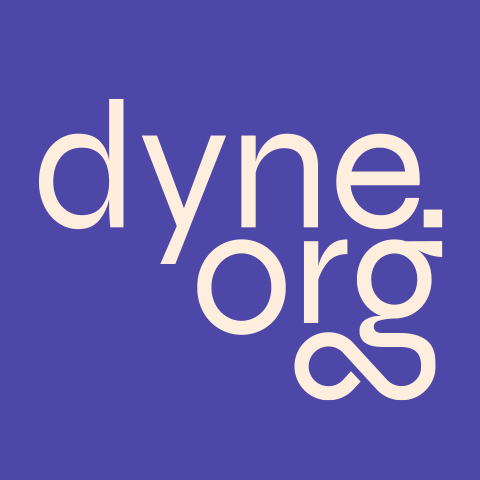How IT infrastructure shapes public life, and how alternatives like free software and open formats can offer healthier paths forward
Data is everywhere. Europeans spend on average about 6 hours and 40 minutes online each day. Data capture is a silent process that occurs through our smartphones, public services, transportation systems, and healthcare services.
The collected data is processed and transformed into metrics used to quantify and assess performance, progress, and quality in specific areas. Metrics are defined by whoever sets the goals: governments, corporations, researchers, or standardization bodies — often based on what they value, prioritize, or want to control. This means metrics are not neutral: they reflect specific interests and worldviews.

Taking into account that 90 % of the information we consume is defined by algorithms mainly based on engagement tactics and profit driven metrics, it becomes imperative to demystify the data collection and decision-making process, regain sovereignty over our digital traces, so that we can be active and well-informed actors in shaping our public and private lives, instead of passive consumers and unpaid content providers, donating for eternity details about own personal lives.
Following a curated list put together for the Master's In Design for Distributed Innovation students, during the Fab City Round Tables, presenting a small part of ‘what we do not see’:
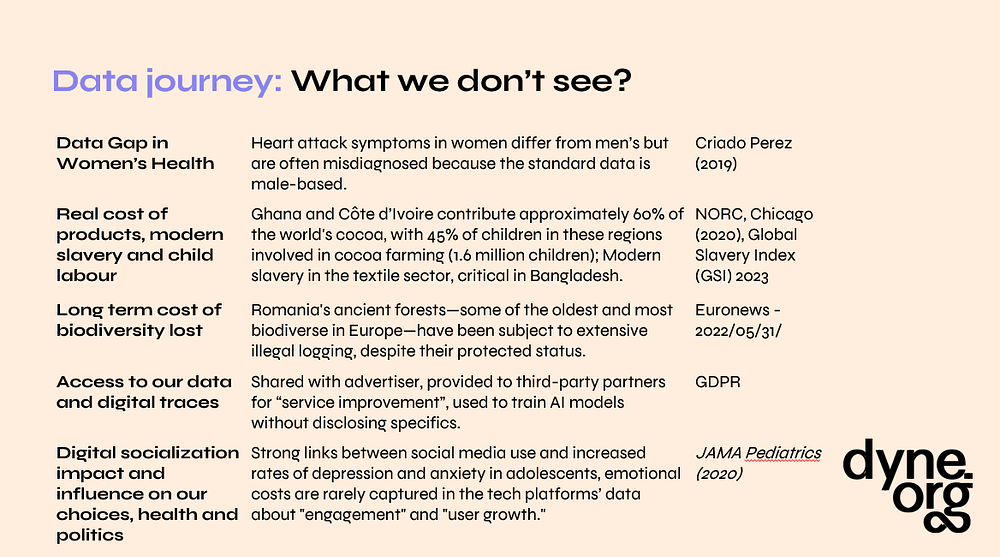
Together with some of the reasons this happens, extracted from the same session:
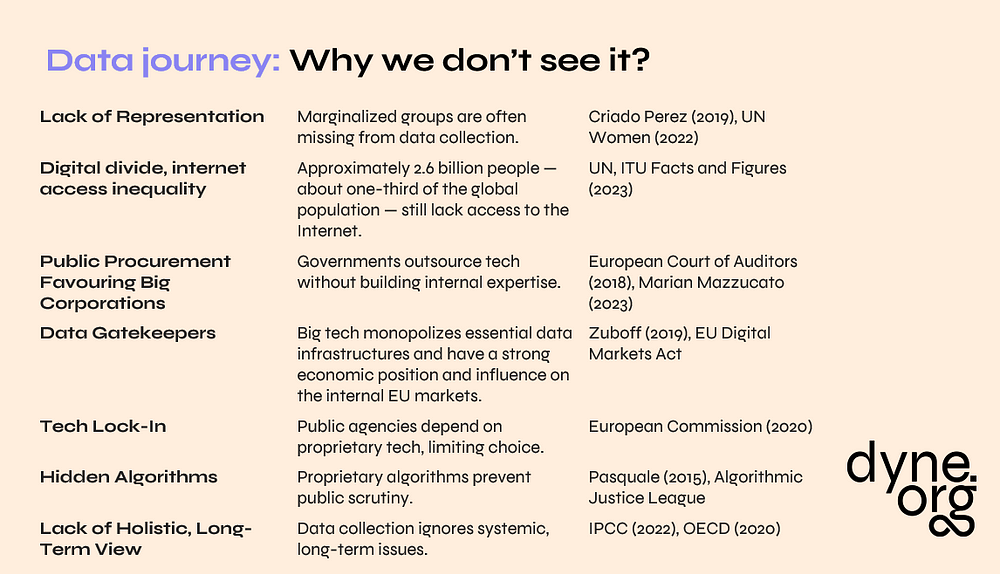
In some EU countries, public services’ communication relies on American providers up to 70%. We cannot outsource these tasks to private foreign companies and expect to serve the citizens, as they, by their nature, serve their stakeholders.
We need our own IT infrastructure and trained professionals! From physical plants, server rooms, and data centres to well-qualified people in charge of running and maintaining them, like system administrators, system integrators, cybersecurity professionals, cloud computing, data analysts, and Machine Learning developers — we need to create the conditions for transparency, inclusion, and innovation driven by public wellbeing, not by private profit.
Alternatively run digital infrastructures
Interfacer project was at the front line of the topic, proposing alternatively run digital infrastructures for FabCities, Regions and Nations, starting with Fab City Hamburg as the first pilot. The project ran for a short period of time, but benefited from all the experience of Dyne.org and was able to lay the foundation of 2 important pillars:
Decentralised Local Nodes
Basic and functional starting point for website, event management, local makers map, for facilitating the nodes’ onboarding process.
A common technological stack providing data exchange standards, principles, and frameworks, such as Open Know How for hardware designs sharing and the Valueflows vocabulary for coordinating the creation, distribution, and exchange of economic resources, ensuring compatibility, coherence, and interoperability between nodes.
This is all public and available, ready for being adopted, studied, modified, and replicated. Contributions, ideas, and proposals are more than welcome!
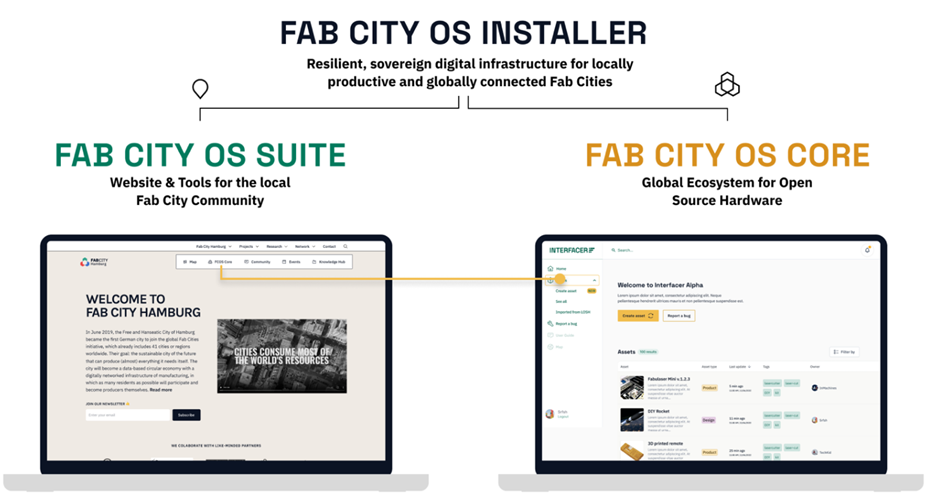
A first instance of a global value exchange system: interfacer.dyne.org
The interaction of three main items is used to capture the entire product life cycle: Design as digital content, blueprints, recipes, etc, Service as a non-physical offering that provides a solution or meets a need, and Product as the physical manifestation of an object.
As an example, a Stool Product may contain: A Design, connected to the git repository, a 4-hour assembly Service, another Product — recycled plastic bars, added as components from the provider, recycled spruce, wooden slats, and screws.
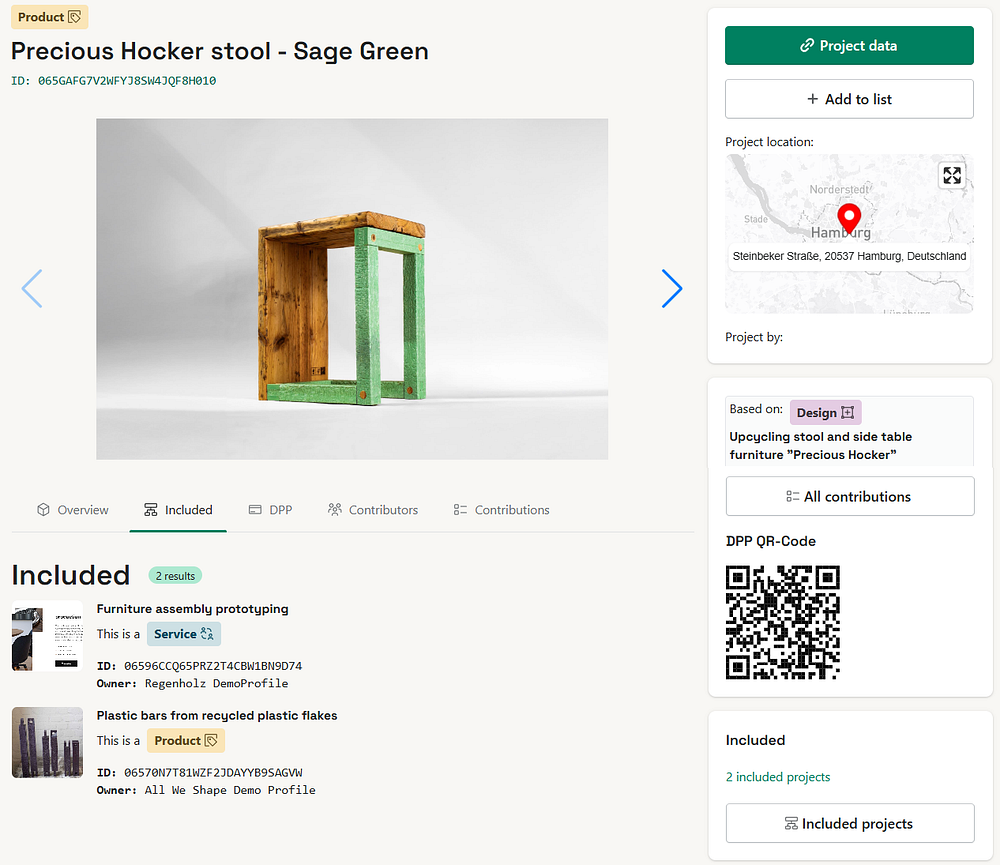
The workflow encourages collaboration as members can:
- Start from already existing components by using the search engine, meant to support finding and integrating existing components, thus saving time and having a point of contact for technical issues and future collaborations.
- Add providers and partners.
- Add contributors that can make suggestions, provide feedback, contribute to the design codebase, and documentation.
Capturing this flow also enables a range of different options, like:
Digital Product Passport & Digital Skills Passport
The relations of these items work as cryptographically signed certificates and can be formatted and aligned with the European Digital Product Passport (DPP) framework, as data carriers, providing information about the product’s value chain.
They also open up a possibility for proving the skills of the collaborators as their contributions, and therefore experience, are being recorded as part of the different process and can be extracted into a Digital Skills Passport.
Creative flows, a basic implementation of a recognition system based on participatory economic theories and activity indicators, was also experimented as a basic step of automatic shared remuneration.

W3C-DID, password-less crypto wallet as an easy entry level, providing end-to-end encryption and ensuring privacy by design to the users, as no personal data leaves the client side, nor is saved on the servers.
In the Interfacer project, we concentrated on Open Source Hardware, but the system can be adapted and can include different workflows, sectors, and also multiple integrations — like marketplaces or feeding urban planning tools, as long as the principles remain aligned. Even so, the project does not cover all the topics mentioned in the first section, and is only a possible start for the creation of a City-level Open Source Ecosystem.
This is not a one-project or one-foundation task; it’s building an alternative and decentralized system with strong appliance in the local communities and a powerful global connection.
We demand multi-level actions
Efforts are being made towards closing the EU ICT workforce gap, but we already know it will not be enough. The contributions need to happen on a multi-level scale:
Global Solutions
Establishing strong frameworks for data governance rooted in human rights is essential. Efforts like the automatic exchange of bank information, introduced by the OECD in 2016, have significantly reduced offshore tax evasion, showcasing the power of coordinated global action.
The promotion of open digital infrastructure — such as open-source software, open standards, and open AI — aligns with the Sustainable Development Goals and is supported by initiatives like the Digital Public Goods Alliance. Global policy principles, including those laid out by the Principles for Digital Development, can guide ethical system design.
Furthermore, governments are encouraged to implement inclusive procurement policies — embodied by campaigns like Public Money, Public Code — to foster open-source alternatives.
Holistic policymaking that links digital transformation with sustainability, as promoted in the European Green Deal and Circularity Gap reports, will be crucial in aligning technology with broader societal goals.
Local Solutions
Cities and municipalities must act as test beds for more ethical and inclusive digital infrastructures. This includes building municipal platforms based on open-source software, reducing dependency on Big Tech, and prioritizing ethical technology in public procurement. Initiatives like Smart Citizen at Fab Lab Barcelona demonstrate how open IT can empower communities through awareness, repair culture, and experimentation, collaborating with local technical institutes through events such as hackathons fosters innovation tailored to regional challenges.
Participatory democracy tools like Decidim enable citizens to co-create policy and governance, promoting transparency and engagement. Moreover, encouraging inclusivity in STEM fields — particularly among youth and women — through grassroots hacker spaces supports long-term digital equity. Supporting local repair ecosystems, like the Restart Project, also contributes to circular and sustainable digital practices.
Individual Actions
We all play a critical role in shaping digital futures through everyday choices and awareness. Understanding how personal data is collected, processed, and shared is the first step toward digital self-sovereignty. The popular adage “If it’s free, you’re the product” reminds us to critically assess the trade-offs in free digital services. Individuals can switch to open-source and privacy-conscious tools such as /e/OS for de-Googled smartphones or secure communication apps like Signal.
Supporting open culture — by reporting bugs, requesting new features, or donating — helps sustain ethical digital ecosystems, as promoted by the Interfacer Project. Getting involved locally, whether through maker spaces, digital repair events, or citizen initiatives, allows all of us to contribute actively to the tech landscape around.
Finally, cultivating digital literacy and critical thinking is essential — asking questions, staying informed, and engaging in collective discussions make for a more resilient and empowered digital society.

To truly see the world — and change it — we must question the data lenses we look through. Let’s define new metrics grounded in care, equity, and ecological awareness, and in doing so, build digital landscapes that illuminate rather than obscure. This is how we create #PocketsOfLight not only in our networks, but in our societies and futures!
